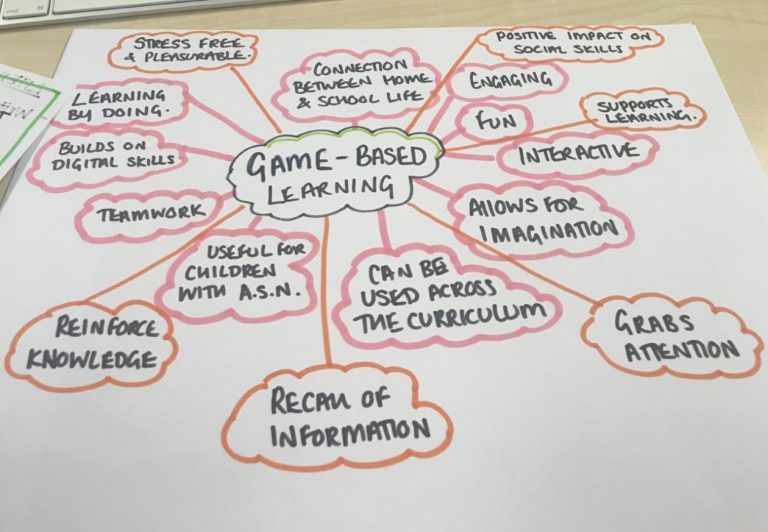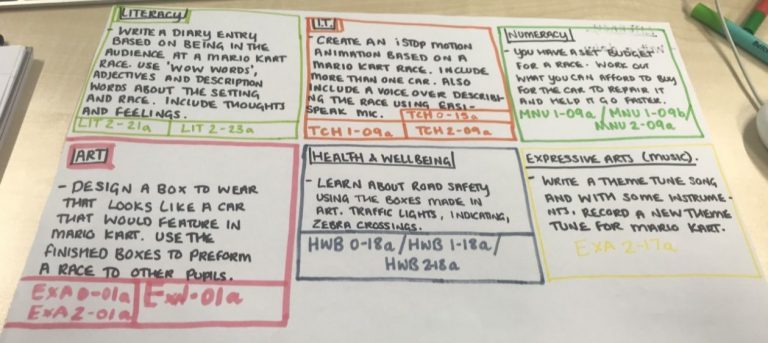Game-based Learning
The focus for today’s input was game-based learning and its benefits in the classroom. We brainstormed why games-based learning could be beneficial and then looked at the use of inter-disciplinary plans. Graham showed us examples of childrens’ work based on one game – I was amazed at how many lessons and how much content could be created and achieved using just one video game.
In groups, we brainstormed the question: why is game-based learning an effective tool to use in education? Our mind-map:

Our original mind-map was written in pink, we added to the mind-map at the end of the input with orange pen
We spoke about how games used in education bring a sense of enjoyment to lessons in school, and are interactive and engaging. The Higher Education Academy supports this as it states “the link between learning and playing is longstanding and predates the digital era by thousands of years” and theorists such as Jean Piaget and Leonard Vygotsky have argued that play is a crucial component of cognitive development. We also noted that bringing games into school would create a connection between home life and school life for children. The idea of learning by doing is very current in today’s education system, and using games to learn helps with this. Using games can also mean teamwork, and therefore improves children’ communicative and collaborative skills. Games can also be used across the entire curriculum, while also building on the pupils’ digital skills. It is argued that games are as high quality materials to deliver lessons as novels, films and plays are (Edutopia). Furthermore, using games allows for imagination and creativity in the classroom with can overlap into creativity in other subject areas such as art and literacy. The Higher Education Academy defines games-based learning as “the integration of gaming into learning experiences to increase engagement and motivation”. At the end of session, we returned to our mind-map and added some extra information that we had learned. This included game-based learning increasing children’s motivation and grabbing attention. We also thought about how games could help the recall of information and to reinforce knowledge. It is also important to note the ‘stress-free’ aspect to using games to learn – some children may find textbooks and traditional techniques stressful and games in the classroom should help with this.
Despite game-based learning having countless benefits in the classroom, it is critical that the games are being used effectively to achieve the best learning possible. Different ways to integrate games into teaching is using the games as a stimulus, using the games to teach content, using the games to teach social skills and also, creating games. It can be daunting to introduce an idea like gaming into a traditional school, as some other teachers may not be as keen to try new things. Stephen Reid says that “although game-based learning has had a ‘difficult history’ with teachers who may have felt threatened by children becoming more expert in technology than they are, there is no denying that such platforms offer them a way to engage the pupils in a way they understand and can relate to”. As Reid has stated, we, as teachers, should try to build our confidence in new areas of technology as it is the key to unlocking our pupils’ creativity and imagination as it is something they can directly relate to. Other challenges to overcome while trying to incorporate game-based learning in class could be resources/budget restrictions; it may seem time consuming; identifying a suitable game; integrating the game into the structure of the school day; and lack of knowledge on how to assess. Some support on how to evaluate a game and its suitability for a classroom could be: make sure the game can be used to develop specific curricular content (eg maths, literacy etc); look at assessment opportunities or the lack of; does the game provide stimulus for further work; problem solving and collaborative working should be involved while using games to learn; how involved will the teacher be and is it likely to engage pupils. Positive answers to these questions leads to an age appropriate game being suitable for use in the classroom.
Inter-disciplinary planning (IDP) allows a teacher to take a single game and make sure that it will cover the curriculum. It shows the number of curricular areas that game-based learning can achieve. Working in a group, we came up with an IDP for using Mario-Kart in the classroom. Before we had brainstormed this, I struggled to even think of one lesson for the classroom, but it is amazing what you can do with one single game. For example, for a Literacy lesson, the children could write a diary entry based on being in the audience of a Mario-Kart race. Asking the children to use adjectives to describe the setting around them and to describe their thoughts and feelings allows them to really immerse themselves in the game. I am learning to use language and style in a way which engages and/or influences my reader. – ENG 2-27a. I can convey information, describe events or processes, share my opinions or persuade my reader in different ways. – LIT 1-28a / LIT 1-29a. For an art lesson, the children could be asked to design their very own kart! They could use large cardboard boxes to wear, decorated to look like a kart that could feature in one of the races. This could be taken even further to produce a drama performance of a tense race between rival competitors. I can create and present work that shows developing skill in using the visual elements and concepts. – EXA 2-03a. I have experienced the energy and excitement of presenting/performing for audiences and being part of an audience for other people’s presentations/performances. – EXA 0-01a / EXA 1-01a / EXA 2-01a.
Our full IDL is shown below: 
Today’s class has really inspired me to use game-based learning in my future class. I can really see its benefits for all children as it is something they can relate to, that brings excitement but also that brings content, questions and growth.
References:
Beauchamp, G. (2012) ICT in the Primary Classroom: From Pedagogy top Practice. Pearson.
Edutopia [Online] https://www.edutopia.org/article/3-ways-use-game-based-learning-matthew-farber [Accessed 6.3.18]
Higher Education Academy [Online] https://www.heacademy.ac.uk/knowledge-hub/gamification-and-games-based-learning [Accessed 6.3.18]
Stephen Reid [Online] http://futurescot.com/educators-encouraged-open-minds-possibilities-games-based-learning/ [Accessed 6.3.18]
